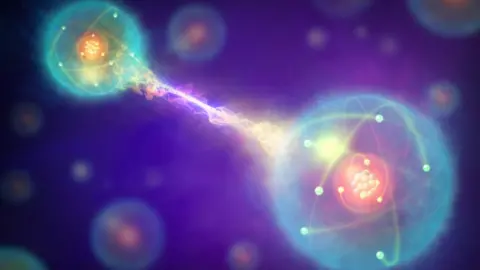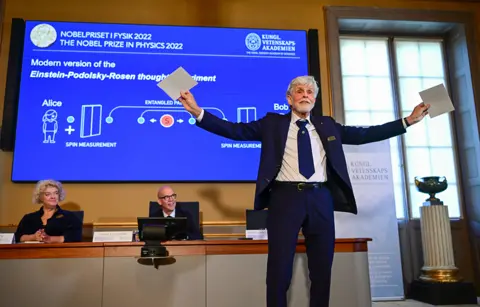Physics Nobel rewards 'spooky science' of entanglement
 EPA/REUTERS
EPA/REUTERSThis year's Nobel Prize in Physics rewards research into quantum mechanics - the science that describes nature at the smallest scales.
The award goes to Frenchman Alain Aspect, American John Clauser and Austrian Anton Zeilinger.
Their work should pave the way to a new generation of powerful computers and telecommunications systems that are impossible to break into.
The men will share prize money of 10 million Swedish krona (£800,000).
 Getty Images
Getty ImagesThis year's three laureates conducted ground-breaking experiments using entangled quantum states, where two sub-atomic particles behave like a single unit even when they are separated.
"Quantum information science is a vibrant and rapidly developing field," said Eva Olsson, a member of the Nobel Committee for Physics.
"It has broad and potential implications in areas such as secure information transfer, quantum computing, and sensing technology."
Alain Aspect, 75, is affiliated to the Université Paris-Saclay and École Polytechnique, Palaiseau. John Clauser, 79, runs his own company in California. Anton Zeilinger, 77, is attached to the University of Vienna.
The same three men won the Wolf Prize together in 2010.
Anton Zeilinger got an early morning call to tell him he'd won. "I'm still kind of shocked, but it's a very positive shock," he said.
Allow X content?
Quantum mechanics describes the behaviour of sub-atomic particles. It's a field that was opened up in the early 20th Century. And it's in a particular aspect of this science that Tuesday's laureates made their name.
It concerns something called "entanglement" in which two or more quantum particles - usually photons, the particles of light - can be strongly connected when very far apart even though they are not physically linked.
Their shared state might be their energy or their spin. It's a strange phenomenon that Albert Einstein called "spooky action at a distance".
The theoretical underpinning was developed in the 1960s by Northern Irish physicist John Stewart Bell. But it was Aspect, Clauser and Zeilinger who then conducted the experiments to show the phenomenon was real and could have practical uses.
"I was always interested in quantum mechanics from the very first moments when I read about it," Prof Zeilinger told BBC News. "And I actually was struck by some of the theoretical predictions because they did not fit the usual intuitions that one might have."
 EPA
EPATwo areas of entanglement research are garnering a lot of attention today. One is in quantum computers which promise a leap in the ability to solve complex problems. And the other is in encryption, the secure encoding of information. Exploiting entanglement will make it impossible for a third party to eavesdrop on private communications.
"This is useful for military and banking, etc, in secure communications," John Clauser said. "The biggest application to my knowledge is the Chinese who launched a satellite several years ago that they use for secure communications over thousands of kilometres."
Commenting, Prof Tim Spiller from the University of York, UK, said the new laureates were worthy winners who had helped to open up an exciting future.
"Quantum technologies have been pursued significantly in the UK and in many other countries worldwide for the last 10 years. We've known about entanglement for rather longer than that, but the investment has been made over the last 10 years to actually really start to exploit this. And there are now one or two commercial products emerging that you can buy that use various aspects of this quantum feature, and we expect there will be many more in the future," he told BBC News.
The Physics Nobel in 2021 was given to three researchers who advanced our understanding of complex systems - in particular, Earth's climate.
On Monday, the Nobel committee gave the Physiology or Medicine prize to Sweden's Svante Paabo for his work on human evolution.

Previous winners of the Nobel Prize in Physics
2021 - Syukuro Manabe, Klaus Hasselmann and Giorgio Parisi were given the prize for advancing our understanding of complex systems, such as Earth's climate.
2020 - Sir Roger Penrose, Reinhard Genzel and Andrea Ghez received the prize for their work on the nature of black holes.
2019 - James Peebles, Michel Mayor and Didier Queloz shared the prize for ground-breaking discoveries about the Universe.
2018 - Donna Strickland, Arthur Ashkin and Gerard Mourou were awarded the prize for their discoveries in the field of laser physics.
2017 - Rainer Weiss, Kip Thorne and Barry Barish earned the award for the detection of gravitational waves.
2016 - David Thouless, Duncan Haldane and Michael Kosterlitz shared the award for their work on rare phases of matter.
2015 - Takaaki Kajita and Arthur McDonald were awarded the prize the discovery that neutrinos switch between different "flavours".
